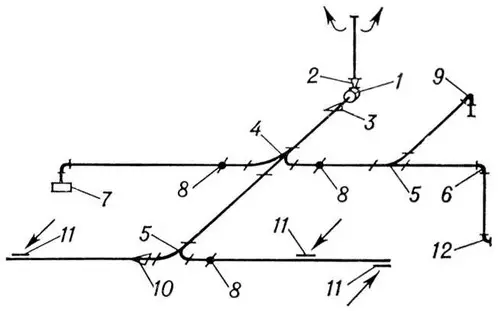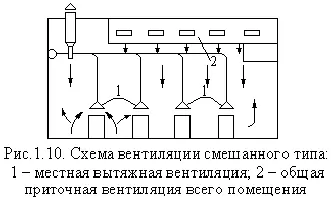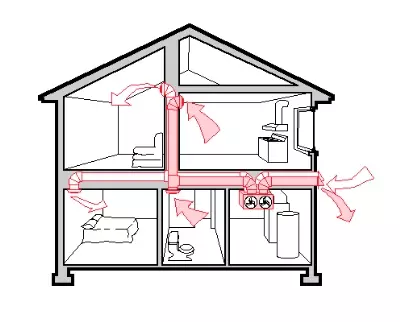
In order to feel comfortable and comfortable in his home and enjoy clean air, a high-quality ventilation and air conditioning system is needed. It is possible only if the system is provided with a normal oxygen flow.

Scheme of the ventilation air ducts: 1 - fan; 2 - Diffuser; 3 - confusion; 4 - Cross; 5 - tee; 6 - removal; 7 - sudden expansion; 8 - valves-flaps; 9 - knee; 10 - sudden narrowing; 11 - adjustable lolly lattices; 12 - Air Aircraft Nozzle.
For the correct air exchange in the system, an aerodynamic calculation of air ducts is needed at the system design of the ventilation system.
The air that moves along the ventilation channels is taken as incompressible fluid. This assumption is possible, since large pressure is not created in the air ducts. The pressure is created by friction of the air mass on the channel surface, as well as when local resistances occur, to which its increases in turning and bending pipes, when dividing or connecting streams, when the diameter of the ventilation channel is changed, or in the installation places of control devices.
The aerodynamic calculation includes the definition of the sizes of the sections of all areas of the ventilation network, which ensure the movement of air mass. In addition, it is necessary to determine the discharge that occurs when the air masses move.
The scheme of creating natural ventilation.
As practice shows, sometimes at the calculations, some of the listed values are already known. The following situations are found:
- Pressure is known, it is necessary to calculate the cross-section of the pipes to ensure the movement of the required amount of oxygen. This condition is characteristic of natural ventilation systems, when the disposable pressure cannot be changed.
- The cross section of the channels on the network is known, it is necessary to calculate the pressure necessary to move the required amount of gas. Characteristic for those ventilation systems whose cross sections are due to architectural or technical characteristics.
- None of the variables are unknown, so it is necessary to calculate the cross section and the pressure in the ventilation system. This situation is the most common in house-building.
Article on the topic: High-quality restoration of sofas with their own hands
Aerodynamic calculation technique
Consider the overall method of aerodynamic calculation at an unknown pressure and sections. The aerodynamic calculation is carried out after the required amount of air mass is determined, which should pass through the air conditioning network, and the approximate location of the aircase system is designed.

Mixed type ventilation circuit.
For the calculation, the axonometric scheme is drawn, where the listing and dimensions of all elements of the system are indicated. According to the ventilation system, the overall length of air lines is determined. Next, the system of air ducts is divided into homogeneous sections, on which the air flow is determined separately. The aerodynamic calculation is made for each uniform area of the network, where there are constant consumption and air mass. All calculated data is applied to the axonometric scheme, after which the main highway is selected.
Determining Speed in Channels
As the main highway, the most extended chain of serial sections of the system are chosen, which are numbered from the remote. The parameters of each site (number, length of the site, air consumption) are recorded in the calculation table. After that, choose the shape of the cross section and calculate the dimensions of the sections.
The cross-sectional area of the line of the highway is calculated by the formula:
FP = LP / VT,
where Fp is the cross-sectional area, M2; LP - air consumption on the site, m3 / s; VT - gas movement speed on the plot, m / s. The speed of movement is determined by the considerations of the noise of the entire system and economic considerations.

Ventilation scheme at home.
According to the obtained cross section, the duct of the standard size is selected, in which the actual cross section (FF) is close to the calculated one.
According to the actual area, the speed of movement is calculated on the site:
VF = LP / FF
Based on this speed, the special tables calculate the decrease in the pressure on the walls of the aircases. Local resistances are determined for each site and are summed up in a general value. The amount of losses due to friction and local resistance is the total value of losses in the air conditioning network, which is taken into account for calculating the required amount of air mass in the ventilation channels.
Article on the topic: Curtains for the hall without lambrequins: stylish solutions for different interiors
Calculation of pressure in the highway
The disposable pressure for each site of the highway is calculated by the formula:DPE = H * G (PH-PB),
where DPE is a natural disposable pressure, Pa; H - difference in the marks of the fence lattice and the mouth of the mine, m; PH and PB - gas density outside and inside ventilation, respectively, kg / m3.
Density from the outside and inside are determined by reference tables based on the outer and internal temperature. Usually, the outer temperature is taken as + 5 ° C, regardless of where the construction area is located. If the outer temperature is lower, the injection into the system increases, which leads to exceeding the volume of incoming air. If the outdoor temperature is higher, the pressure in the system is reduced, but this circumstance is compensated by open vents or windows.
The main task of the aerodynamic calculation is the selection of such air ducts in which the loss (σ (r * l * β + z)) will be equal to or less than the current DPE:
Σ (R * L * β + z) ≤ DPE,
where R is a friction loss, P / m; L is the length of the site, m; β - coefficient of roughing wall walls; Z - Reducing the gas rate from local resistance.
The value of the roughness β depends on the material from which the channels are made.
| Speed, m / s | Material duct | |||
| Shagohyds. | Slagobeton | brick | Stucco on the grid | |
| 0.4. | 1.08. | 1,11 | 1.25. | 1,48. |
| 0.8. | 1,13 | 1,19 | 1,4. | 1,69. |
| 1,2 | 1,18. | 1.25. | 1.5 | 1,84. |
| 1,6 | 1,22 | 1,31 | 1,58. | 1,95 |
The stock is recommended to be taken into account ranging from 10 to 15%.
General aerodynamic calculation
In the aerodynamic calculation, all the parameters of the ventilation mines are taken into account:
- Air flow L, M3 / h.
- The diameter of the duct D, mm, which is calculated by the formula: d = 2 * A * b / (a + b), where a and b are the size of the channel cross section, mm.
- Speed V, m / s.
- Pressure loss for friction R, P / m.
- Dynamic pressure P = DPE2 / 2.
Calculations are performed for each channel in the following order:
- The required channel area is determined: F = L / (3600 * VREK), where F - area, m2; VREK is the recommended speed of air masses, m / s (taken equal to 0.5-1 m / s for channels and 1-1.5 m / s for mines).
- The standard cross section is selected, close to F.
- The equivalent diameter of the duct d is determined.
- Using special tables and nomograms for L and D, the decrease in R, the speed V and pressure P. are determined.
- According to the tables of local resistivity coefficients, the decrease in oxygen is determined due to the local resistances of Z.
- The total losses on all areas are determined.
Article on the topic: how to make an antenna for a TV with your own hands
If the total losses are smaller than the current pressure, then this ventilation system can be considered effective. If the loss is more, then the throttle diaphragm can be installed in the ventilation system, which you can exhaust excess pressure.
If the ventilation system serves several rooms in which a different pressure is needed, then when calculating, it is also necessary to take into account the value of the side or discharge, which is added to the value of common losses.
Aerodynamic calculation is the necessary procedure in the design of the ventilation system. It shows the efficiency of ventilating rooms at specified channel sizes. And efficient ventilation work provides the comfort of your stay.
